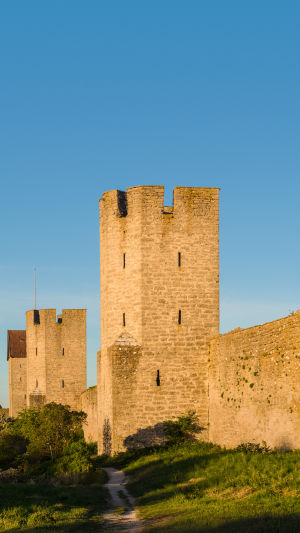Visby, located on the island of Gotland in the Baltic Sea, is one of Sweden's most beautifully preserved medieval cities. Known for its unique city walls, cobblestone streets, and scenic views, Visby offers a captivating blend of history and natural beauty.
This travel guide provides Lykkers with all the essential details for planning an unforgettable trip to Visby, a UNESCO World Heritage site, and a gem for any history lover or nature enthusiast.
<h3>Getting to Visby</h3>
<b>By Air</b>: The most convenient way to reach Visby is by flying to Visby Airport, located just 5 kilometers from the city center. Direct flights are available from Stockholm, with a flight duration of about 40 minutes. The airport offers convenient taxi and bus services to the city center, with taxis costing around 200-300 SEK, and buses costing 35 SEK for a single ride.
<b>By Ferry</b>: For those who prefer a scenic journey, ferries from Nynäshamn (about 1 hour from Stockholm) run frequently to Visby, with the journey taking around 3 hours. Prices for ferry tickets range from 200 to 350 SEK depending on the season and type of ticket.
<h3>Exploring Visby: Must-See Attractions</h3>
<b>1. Visby City Wall (Ringmuren)</b>
One of Visby’s most iconic attractions is the Visby City Wall, a 3.5-kilometer stone wall that encircles the old town. Built in the 13th century, this well-preserved fortification features 27 of its original 29 towers and offers a glimpse into Visby’s medieval past. Walking along the wall or admiring it from the nearby pathways is a must for any visitor.
<b>Entry Fee</b>: Access to the wall is free, though guided tours are available for around 100 SEK.
<b>Open Hours</b>: Open year-round, though the best times to explore are in the morning or late afternoon to avoid crowds.
<b>2. Botaniska Trädgården (Botanical Garden)</b>
For a peaceful escape from the historical streets, the Visby Botanical Garden is an enchanting oasis of greenery. Established in the mid-19th century, the garden features a diverse array of flowers, trees, and plants, as well as beautiful views of the nearby ruins.
<b>Entry Fee</b>: Free admission.
<b>Open Hours</b>: The garden is open to visitors daily from dawn to dusk, making it a perfect place for a morning stroll.
<b>3. Almedalen Park</b>
Situated just outside the city wall, Almedalen Park is another beautiful spot to relax and enjoy Visby’s natural surroundings. The park offers scenic views of the Baltic Sea, well-maintained lawns for picnics, and walking paths lined with benches. It’s also a popular venue for local events, particularly during the summer.
<b>Entry Fee</b>: Free admission.
<b>Open Hours</b>: Open daily from dawn to dusk.
<b>4. Gotland Museum</b>
To learn more about the fascinating history of Visby and the island of Gotland, a visit to the Gotland Museum is highly recommended. The museum features exhibitions on medieval life, Viking history, and archaeological discoveries from the region.
<b>Entry Fee</b>: 120 SEK for adults, 80 SEK for students, and free for children under 18.
<b>Open Hours</b>: The museum is open daily, but hours vary depending on the season, so it's advisable to check the schedule beforehand.
<b>5. Visby Harbor</b>
Visby’s picturesque harbor is a lovely place to take a leisurely walk, watch the boats come and go, or enjoy a meal at one of the nearby cafes. The harbor area is bustling with life, especially during the summer, and offers a peaceful view of the Baltic Sea.
<b>Entry Fee</b>: Free admission.
<b>Open Hours</b>: Open year-round.
<h3>Unique Experiences in Visby</h3>
<b>Medieval Week (Medeltidsveckan)</b>: For those visiting in early August, the Visby Medieval Week is a lively festival that brings the city’s history to life with costumed parades, jousting tournaments, and medieval markets. It’s a fun and immersive way to experience the city’s past.
<b>Visby’s Ruins</b>: Scattered throughout the city are ancient ruins, adding an air of mystery to the already historic town. These sites are open for exploration and offer stunning photo opportunities, especially at sunrise or sunset.
<h3>Best Time to Visit</h3>
Visby is a year-round destination, but the best time to visit is during the summer months (June to August) when the weather is warm, and the city is in full bloom. This is also when many of the seasonal activities and festivals take place. For a quieter visit, late spring (May) and early fall (September) offer pleasant weather without the summer crowds.
<h3>Practical Tips</h3>
<b>Getting Around</b>: Visby is a compact city, and most attractions are within walking distance. Bicycles are also a popular mode of transport, and there are several rental shops available. For those wanting to explore beyond the city, public buses and taxis are readily available.
<b>Where to Eat</b>: Visby has a great selection of local eateries that offer Swedish cuisine, including fresh seafood, regional specialties, and traditional dishes. Many restaurants are located along the harbor or within the old town, providing scenic dining experiences.
<b>Accommodation</b>: From charming boutique hotels to guesthouses, Visby has a range of accommodation options to suit different budgets. Booking in advance is recommended, especially during the summer months.
<h3>Final thoughts</h3>
Visby is a destination that seamlessly blends history, nature, and charm. Whether you're walking along the medieval city wall, exploring the lush botanical gardens, or enjoying the vibrant harbor, Visby offers a unique travel experience that’s both tranquil and full of discovery. For Lykkers and other travelers looking for a peaceful escape with rich history, Visby is an unforgettable journey waiting to happen.





